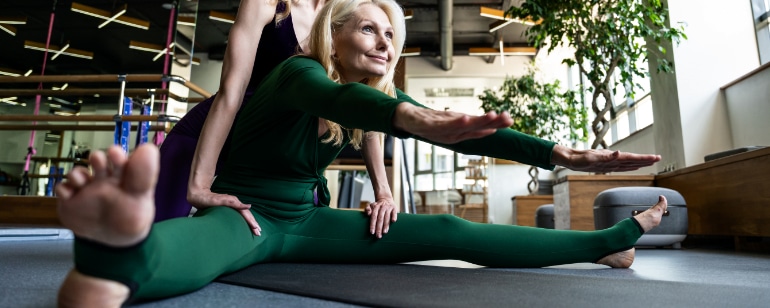Groin pain can be triggered by various causes, such as muscle tension, hernias or hip problems. Many patients suffer from tense muscles and fasciae, which can lead to various symptoms. If the cause of hip pain is actually due to tension in certain muscles and fascia, physiotherapy can effectively reduce symptoms.

What causes groin pain?
Tension in the muscles
In the case of groin pain, an inspection of the adductor muscles, i.e. the muscles located on the inside of the thigh, may be considered. If muscles in the region are overloaded, strained by incorrect movements or tense due to too little movement, this can manifest itself in the form of groin pain. The iliopsoas, the deep hip muscle, can also suffer from tension, which can cause pain in the groin.
Strain on the fasciae
In addition to muscle tension, fascial tension can lead to deep-seated pain in the groin. As fasciae are connective tissue structures that envelop muscles and organs, tension can not only lead to pain but also to restricted movement. The trigger is usually adhesions or hardening of the fasciae, which can cause pain.
Other causes of groin pain
Other possible causes of groin pain include an inguinal hernia, where tissue leaks through a weak point in the abdominal wall and causes pain in the groin area. Hip problems, such as osteoarthritis of the hip joint or inflammation of the hip joint, can also lead to groin pain. In addition, problems with the internal organs, such as the bowel or urinary tract, can radiate pain into the groin.

Physiotherapy for groin pain
Physiotherapy focuses primarily on freeing muscles and fasciae from tension, but also on strengthening them so that they can ensure good stability.
Exercises to relax the muscles
Stretching exercises are used as part of physiotherapy. The aim of these is to improve the flexibility and elasticity of the tissue. If the muscles are stretched, tension can be released and movements become smoother. It can also be used to compensate for muscular imbalances.
Massages to relieve groin pain
Physiotherapists use pressure and kneading techniques to loosen tense muscles and fascia and promote blood circulation. This supplies the tissue with nutrients and oxygen. If tension is released, adhered or hardened fasciae can be loosened, resulting in a reduction in pain.
Ergonomic posture
As physiotherapy not only treats the symptoms, but above all the causes, it is possible to train for an ergonomic posture that can provide long-lasting relief. Certain movement patterns and sitting postures can damage the body in the long term, resulting in blockages and tension, whether long or short. Good posture can be trained and should be integrated into everyday life so that the body remains healthy in the long term, because it is clear that good posture in everyday life and at work can help to avoid muscle tension and keep the body flexible.
Sporting activities
Light exercise, such as walking, yoga, cycling or swimming, plays an important role in the prevention and treatment of tension. Regular activities increase blood flow to the muscles and mobilize them, which helps to prevent tension and alleviate existing tension. These movements help the body to regulate itself and contribute to general physical and mental relaxation.
Groin pain can have various causes. Physiotherapy can help to relieve tension and blockages. If the cause lies in tense muscles or fascia, a physiological approach is the best way to eliminate symptoms.
